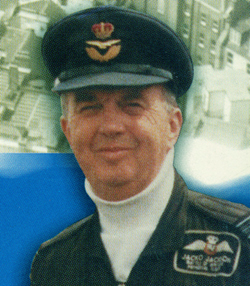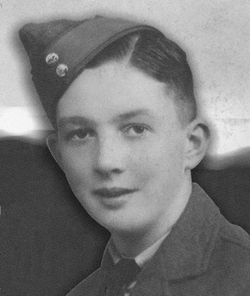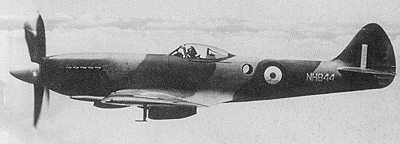
This manuscript article
was given to our Committee Member Peter Wesson by Sqdn. Ldr.
Jackson. Tucked away on the last page were the following few
lines which provide an appropriate context for the main article.
'One or two details of 'Jacko' Jackson's flying career: After
44 years in the RAF during which he flew continuously for just
over the last 40, without a ground tour, on 34 Types and always
as first pilot having been a direct-entry Captain on both the
Hastings and the Belfast Transports, his total flying hours were
just over 12,000 hours without scratching the paint. When he
left the RAF he became a civilian Flying Instructor at Sherburn-in-Elmet
in Yorkshire for 12 years amassing another 7,000 hours on 38 new
Types and again without scratching the paintwork. Although 'Jacko'
is proud of his Spitfire days the highlight of his flying career
was undoubtedly becoming O/C BBMF and flying the Lancaster "City
of Lincoln" for seven years after the demise of the Hastings
which he had flown for over 5,000 hours.'
"About the only way of becoming an RAF Pilot pre-WWII without
being selected for a Cranwell Cadetship or a short-service
Commission, which both called for a very high level of
education, was to join the RAF in a ground trade and hope that
one might became an NCO Pilot for a fixed four-year period. With
that in mind I joined the RAF as a "Trenchard Brat" (Halton
Apprentice) signing on the dotted line on my 16th birthday in
1939, little realising that it would be 44 years later before I
finally left on my 60th.

Having been trained as a Fitter II Airframes, the technical
world was very reluctant to let one re-muster to aircrew despite
the demands of WWII. I finally managed to escape in 1943 and,
after gaining my Wings in Southern Rhodesia, proceeded to Egypt
to join No. 73 OTU, RAF Fayied.
The first question asked there was which type did one wish to
convert to: Spitfire, P47 or Tomahawk? I thought everybody would
want the Spitfire but, thankfully, quite a few who had, perhaps,
been unhappy with their landing skills during training opted for
the P47 with its wide undercarriage - shades of Mel09/Fwl90 and
the Hurricane/Spitfire! Another factor might have been that
Tomahawk pilots would definitely proceed to Italy and fly
Mustangs, and those on P47s to India then Burma..
Came the day, after more Harvard flying, when I achieved my
ultimate ambition - to fly a Spitfire. After a thorough briefing
and supervised start-up, my Instructor sat on the port wing tip
as I taxied out and, just before take-off, came and had a final
look around the cockpit, probably to make sure that the glycol
temperature was not approaching its max. limits. After a
successful take-off I had a sense of feeling never known to me
before: "I'm flying a Spitfire" I kept saying to myself, "And
all I have to do now is to make a safe landing" which I duly
did. Oh, what a day!
On one occasion when carrying out exercises over the uninhabited
land East of the Suez Canal, my Spitfire-flying nearly came to a
dead end (if you will pardon the pun). It was my turn to carry
out a Height Climb which, in effect, meant climbing until the
rate of climb was down to about 200' / min. which, on a Mk.V
Spitfire, took place at about 35,000 ft. After reaching that
height I circled around and, after spotting an aircraft-carrier
transiting the Suez Canal I decided to put my Spit' into a steep
dive to get a better view of it. Needless to say the speed built
up rapidly and when I tried to pull out at about 20,000 ft.
nothing happened. After repeated efforts with the aircraft
shuddering like mad, with still no sign of recovery, I thought
the only option left was to try and bale out. First of all I
pulled the canopy release toggle but, luckily for me in
retrospect, it did not work. Next I decided to use the crowbar,
normally fitted to the port entrance door flap, but it had been
removed for some reason or other. When down to about 10,000 ft.
signs of recovery started and the airspeed indicator began to
drop rather rapidly which did not worry me at first because the
throttle had obviously been closed at that point. However, when
the speed was getting rather low, or so I thought, I opened up
but still the asi was dropping and I concluded that the engine
had blown in the dive and I would have to make a forced landing
on the desert floor. It was when I lifted the nose to reduce to
landing speed for a belly landing that the aircraft suddenly
shot back up to about the 10,000 ft. mark. Obviously the asi
needle had been once around the clock. In those far off days the
word "compressibility" was not in use in the aviation world, nor
the term "the Sound Barrier".
When I tried to explain my experience to my Flight Commander he
would have none of it and dismissed my version out of hand,
insisting that I had obviously failed to turn on the oxygen
supply although I was absolutely certain that was not the case.
After completing our OTU Course, six of us spent 2 most
memorable days on a Short 'C' Class Flying Boat bound for
Karachi, which were followed by 6 days by train down to Poona
to convert to Spitfire Mk. XIIIs, during which we carried out
live dive bombing. After a week's Jungle Survival Course at
Bhopal we thought that, at long last, we would be joining a
Burma Spitfire Squadron but it was not to be. Instead, a number
of Griffon-powered Mk. XIVs arrived at Poona which, after a few
familiarisation flights, we were tasked with carrying out
practice aircraft-carrier take-offs. This called for a 15° flap
setting. With the Spit, having only two settings, 'up' or
'down', we had to select 'down' when one block of wood was
placed under each flap and then select 'up' to jam them in
place. After take-off we would select 'down' to release the
blocks into space. When we asked our bosses where to drop them
with Poona well inland from the Indian Ocean, they replied
"Anywhere you think is safe." The open-air latrines 100 ft.
behind our Crew room proved to be the most popular choice.
Still being wartime and the left hand not always knowing what
the right hand was doing all the time, it was not a complete
surprise to find after a two-day rail journey to Nagpur to
collect some more Mk. XIVs and take them to the Naval Base of
Trincomalee in Ceylon, we discovered that they had already been
collected by ferry pilots. It was then off by train again to
catch up with them. After arrival it turned out that we would be
part of a second wave of aircraft of Operation "Zipper": The
Invasion of Malaya / Singapore, to replace the expected 50%
loss-rate to Nos. 11, 17 and 132 Squadrons during the planned
landings. In the event, it was during our train journey that
news of the Atomic attack on Hiroshima broke. However it had
been decided to continue with the operation and so it came about
that Nos. 11 and 17 Squadrons would land in Malaya via the
escort carrier "Trumpeter", and No. 132 would proceed to Hong
Kong via another carrier. What could not have been foreseen was
that with no loss of pilots or aircraft, the Poona element was
surplus to requirements - for the time being anyway. That was
resolved by posting our group of six pilots to No. 152
(Hyderabad) Squadron, which had already arrived in Malaya direct
from Burma by using 170 gallon drop-tanks (why was it so late in
the war before they came into use?).
Going back to Mk. VIIIs was no bad thing being a lovely aircraft
to fly, although I was involved in three incidents in a small
time scale, only one of which was of my own making. The first
when flying as No. 2 to my Flight Commander when he spotted
another formation of four from our Squadron and decided to take
us down on a mock attack. With only a few hundred yards to go
the was a mighty roar of one of those aircraft when it passed
about 20 ft. above my cockpit and then straight into the tail of
our Leader. I will always remember being transfixed by the sight
of the offender's propeller soaring high into the sky in a big
arc to the right. Both aircraft belly-landed on the Naval Air
Base of Sambawanga - I would love to have heard their
conversation!
The next incident was during a formation take-off flying No. 2
to another NCO Pilot who, with three tours of operation under
his belt, was one of the most experienced Spitfire Pilots in the
RAF. Just after he had lifted off and I was still on the ground,
he suffered a complete engine failure and sank back onto the
runway with our wings overlapping. I had to give a sharp pull
back on the stick to leapfrog his starboard wing. Although in
this case it was not fuel starvation that caused the problem it
is worth recording that, in the early days of the Spitfire, many
accidents occurred because the fuel system was such that a
start-up, taxi-out, engine test and the start of a take-off
could all be carried out with the fuel master cock in the
'off' position before a failure occurred. The answer had been to
wire-lock the cock in the 'on' position. During second-line
servicing it often needed to be unlocked and, occasionally,
returned to first line in that state.
The last incident occurred when I was carrying out aerobatics
over the island and the engine failed. With the Western
coastline the nearest, I started to glide towards it but soon
realised that I was not going to make it. Panic stations!
Looking for any area without trees in the Western part of the
island proved fruitless so was it to be another attempt at a
bailout? The day was saved when the engine suddenly burst into
life again. During de-briefing, my Flight Commander asked if I
had pressed the de-aerator button and I had to admit that I did
not even know one was fitted to the Mk. VIII. Shortly after, the
Squadron started to re-equip with Mk. XIVs and we new boys found
ourselves pointing out one or two things to the old hands! Like
ourselves at Poona, they found the Coffman cartridge starter a
bit of a problem at times. It was only a few weeks later that
the news broke that the Tengah airfield was to be closed for
some time for the building of a brand-new runway. Our sister
Squadron No 155 was sent to Sumatra and No 152 temporarily
disbanded with members posted far and wide except for our little
group who had flown off a Carrier. We were all posted to the two
Squadrons due to occupy Japan: Nos. 11 and 17, and would be
transported by a much larger Carrier this time, HMS Vengeance,
for the voyage.
We had to take the few Mk. XIVs on No 152 to Kuala Lumpa to join
No 11 Squadron and it could not have happened to many RAF Pilots
to take their own aircraft with them on a posting to a new
Squadron with all their worldly belongings tucked into the
aircraft ammo bays!
After boarding HMS Vengeance by tender off RAF Saletar, we found
No 4 RIAF Squadron with their Spitfires already on board. After
arriving off Iwakuni in the Inland Sea, it was decided not to
fly our aircraft off the carrier because Japanese tenders could
off-load them with ease. Our base was to be Miho on the North
Coast, but it was to be seven days before that took place. After
inspections by our ground crews, we air-tested our aircraft and,
with Hiroshima only a few miles away, we all headed towards it
for a good look at the damage caused by the first atom bomb.
Just who was the first Spitfire pilot to take-off from Japan? It
was the one and only "Ginger" Lacey on the first day of Air
Tests. The air was calm and, after our Squadron Commander had
started his engine to taxi out to the end of the only runway,
Ginger jumped into his aircraft and taxied rapidly to the other
end. They both lined up for the take-off and all onlookers
assumed that one or the other would give way, but it was not to
be. Just when a head-on collision seemed unavoidable, Ginger
leapt over the COs aircraft and got away with it. Having
experienced the roar of a Merlin just above my cockpit in
Singapore, I knew what our Boss must have felt like.
Life in Miho was rather quiet except for one or two special
occasions such as one mass formation of all British Commonwealth
Squadrons. It was led by one New Zealand Corsair Squadron, then
three Australian Mustang Squadrons and our Wing. The lead
Corsair flew at such a low speed that we had to open our
radiator shutters to induce extra drag and use more power for a
better throttle for formation flying. For unknown reasons
it was decided to mount sea patrols between our coastline and
that of Korea and report details of any junks sighted -
position, heading etc. It was also at that time that our
aircraft would carry ammunition and that all guns/canons be
tested for accuracy on a ground target. It was decided that a
small rock island in a bay just about two miles off our main
runway would be ideal.. Some of us made our first attack just
after take-off and one day I was too late for my first dive and
on the second one, with my finger on the firing-button, I
noticed a Japanese fisherman in a small boat rowing like mad
away from the rock with his rod dangling over the rear - it was
his lucky day!
On returning to the U.K. I assumed that my Spitfire-flying days
would be all over and that I would find myself on a jet-fighter
Squadron. However it was not to be. The C in C of Fighter
Command had decided that, in future, his Pilots should all be
Officers, although he would have to make do with the NCO Pilots
already on Squadrons, so I found myself on Support Units for a
few years. This involved towing targets for air-to-air and 'ack-ack'
firing (Martinets); night flying for searchlights (Oxfords) and,
luckily, making the odd trip in Spitfire Mk. XVIs fitted with
Packard Merlin engines which I found to be an ideal combination
(although in Lancaster Mk. IIIs each engine was fitted with one
extra fuel cut-off switch, all four very close together on the
right-hand side of the cockpit and, therefore, not very popular
with bomber crews wearing heavy-duty flying gloves at 20,000 ft
on dark nights!).
The Spitfire flying was mainly going up and down a straight line
at about 12,000 ft in the South Eastern area of the UK. The
most popular run was from Regent's Park - the first station for
most WWII aircrew - up to a point on the A1 about 50 miles to
the North. Regent's Park often became Buckingham Palace!
I thought that after being selected for a Flying Instructor
course at RAF Little Rissington in 1949, that would be the end
of my Spitfire-flying days. However, we soon found out that part
of the course was "Type Flying" and the Spitfire was one of the
eight types that we would get our hands on.
After Commissioning in 1951 I was posted to instruct on No 22
FTS at RAF Syerston, which was mainly concerned with the
training of Royal Navy Pilots and, low and behold, they had a
lone Seafire for the use of RN Instructors to keep their hands
in. However, they did not mind RAF Pilots flying it too. After I
had moved on from Syerston they replaced the Seafire with a Sea
Fury, a type I would love to have flown.

Pictures courtesy of Tucann
Books
www.tucann.co.uk
--------------------------------------------------------------
Previous Spitfire Society interviews can be found in the
Archives section:



